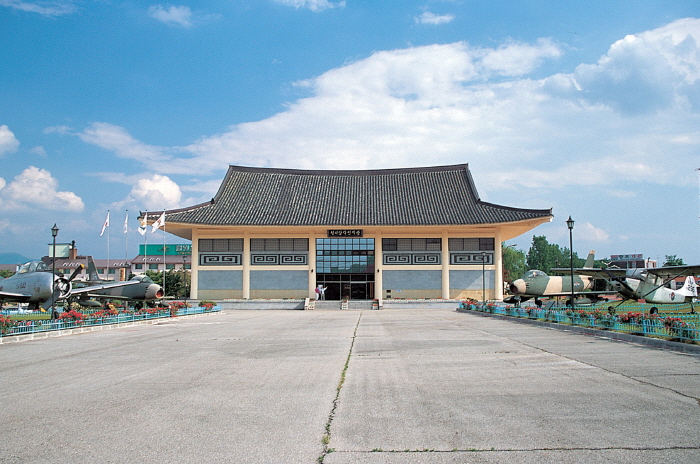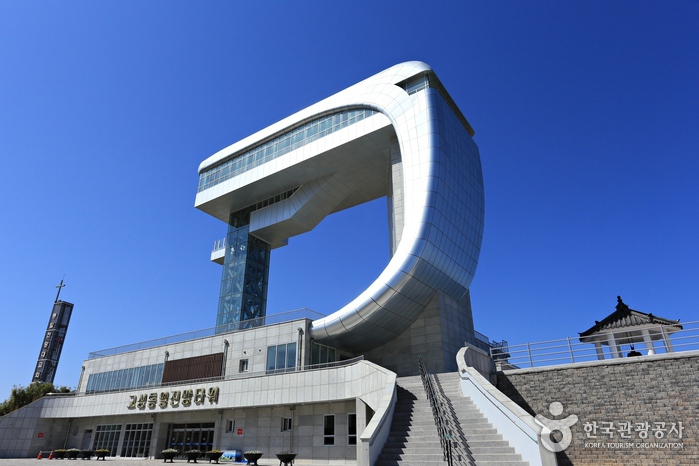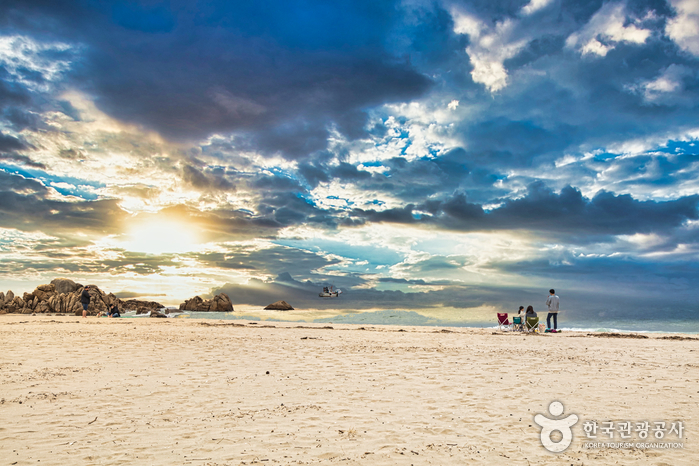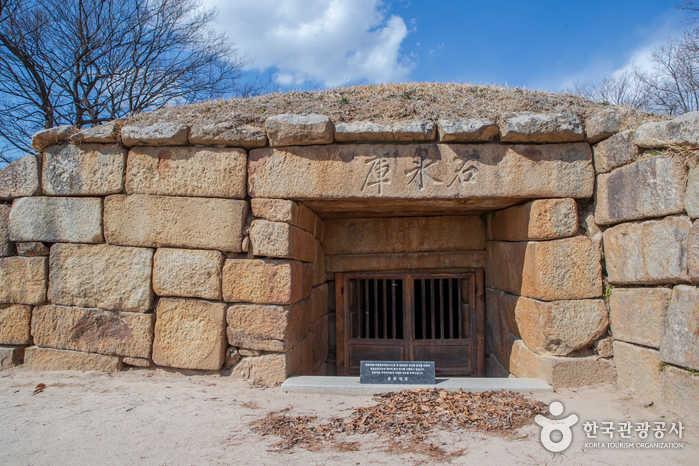Cheorwon Facilities Management Office (Formerly, Iron Triangle Battlefield (철원 시설물관리사업소 (구 철의삼각전적관))
2025-03-15
1825, Taebong-ro, Cheorwon-gun, Gangwon-do
+82-33-450-5559
Located in Goseokjeong National Tourism Site, Cheorwon Facilities Management Office is the main tourism center hosting the Cheorwon tour. Starting from Security Tourist Site Development Plan by Cheorwon-gun county in 1976 , the Ministry of Transportation designated Goseokjeong as Goseokjeong National Tourist Area in 1977. The military and Cheorwon-gun county carried out security and battlefield excavation and preservation projects, and established a security educational site featuring the national largest scale in 1985.
Presently, the Iron Triangle Battlefield, located in Goseokjeong National Tourist Area, is used as a security educational site. Unification Hall found within houses various exhibitions, giving information to compare with current and past lifestyles and military devices including varied aircrafts displayed in the outdoor exhibition area. In the educational hall, a promotional video for Cheorwon is screened. Likewise, the exhibition hall covers various materials that allow one to think about unification between North Korea and South Korea.
Goseong Unification Observatory (고성 통일전망타워)
2025-03-26
481 Geumgangsan-ro, Hyeonnae-myeon, Goseong-gun, Gangwon-do
+82-33-682-0088
The Goseong Unification Observatory stands as the northernmost observatory in South Korea. It provides panoramic views of the DMZ, the East Sea, and North Korea's Geumgangsan Mountain. Established as a symbol of hope for the reunification of the Korean Peninsula, it features an exhibition hall dedicated to educating visitors about the Korean War (1950-1953). Due to its location near the DMZ, visitors must bring an ID, such as a passport or foreigner resident card, for entry.
Hajodae Beach (하조대해수욕장)
2025-01-21
35 Hajodaehaean-gil, Yangyang-gun, Gangwon-do
+82-33-672-2346
Hajodae Beach, located in Yangyang-gun, is famous for the beautiful scenery of the deep blue ocean, soft sandy shore, a nearby lighthouse, and unique rock formations and stony islets. The beach is roughly 1.5 kilometers long, at an average x_width of 100 meters, and a coastal incline of 1.5 meters. Gwangjeongcheon and Sanguncheon Streams run into the ocean near the beach, creating slightly warmer waters than other areas along the eastern coast. During the summer season, visitors can pay to pitch a tent on the beach or in the pine forest campground. The beach is complete with a parking lot, shower booth, drinking fountain, and restroom among other amenities. The beach is open for swimming between July and August, and is the venue for many festivals and events throughout the year. Hajodae Pavilion, one of the Eight Scenic Sights of Yangyang, and a skywalk observatory are located nearby.
Hwajinpo Lake (화진포(화진포호))
2021-08-10
Geojin-eup, Goseong-gun, Gangwon-do
+82-33-680-3677
Hwajinpo Lake is the largest lagoon in Korea with its sand made from seashells and rocks that were broken down over thousands of years. With soft sand and shallow waters, it is a popular beach location. In winter, various migratory birds and swans can be seen, as the birds enjoy clean water and food from the field of reeds. Because of its excellent scenery, Kim Il-seong of North Korea and the former South Korean President Rhee Syngman and Vice-president Lee Ki-poong had summer houses here. It also has Hwajinpo Museum of History with more than 40,000 artifacts from 1,500 species.
Seokbinggo (Stone Ice Storage) (경주 석빙고)
2020-04-06
Inwang-dong, Gyeongju-si, Gyeongsangbuk-do
+82-54-779-6100
Seokbinggo means a freezer made of rocks. It is an ancient refrigerator only in Korea. It is located in Gyeongju, the ancient capital of the Silla Era (BC57-AD935). The appearance of this wonderful vestige is humble and simple. But you will not be disappointed at the entrance of the freezer. You can feel the cold from inside the structure. Half of Seokbinggo is underground while the other half is above ground, signifying the scientific propensity of Korea. The floor, walls, and ceiling are made of granite and have an airway. The walls are covered with limestone to keep off moisture and water. The floor is slanted to allow melted ice to funnel out. Frozen ice was popular for the upper class. From historical annals, it is assumed that Seokbinggo was made at least 1,500 years ago. Seokbbingo has been designated as National Treasure No. 66.
Taejongdae Cliffed Coast [National Geopark] (태종대 (부산 국가지질공원))
2024-04-26
24 Jeonmang-ro, Yeongdo-gu, Busan
Taejongdae Cliffed Coast was formed by many layers of rock being forced together beneath a lake during the Cretaceous period, and then worn away over time by the sea. The coast features many geological formations, including sea caves and uniquely shaped rocks. Visitors can enjoy walking on the forested paths, or take the train course to easily access Taejongdae Observatory and Yeongdo Coastal Culture Space.
Jumunjin Beach (주문진해변)
2023-10-16
210, Jumunbuk-ro, Gangneung-si, Gangwon-do
+82-33-640-5422
Jumunjin Beach is located in the northernmost part of Gangneung, and is a great place for summertime family vacations due to the beach's shallow water. The sound of calm waves will chase the heat away, while the dense pine forest provides cool shade against the sun. Visitors can take advantage of the amenities along the beach as well, such as the forest fitness park, family hotels, and the nearby campsite.
Jeongdongjinhaebyeon Beach (정동진해변)
2024-12-26
17 Jeongdongyeok-gil, Gangneung-si, Gangwon-do
Jeongdongjinhaebyeon Beach is a nice, sandy beach with three major swimming spots: in front of Jeongdongjin Station, by Sandglass Park, and by the Jeongdongjin Breakwater. The spots near the railway station and by the park are more popular because they are spacious and easy to reach. The numerous rocks in front of Jeongdongjin Station are home to shellfish, mussels, sea urchins, and edible seaweed.
Jeondongjin Station is known to be one of the stations closest to the ocean in the world. It is also a well-known sunrise spot, attracting crowds of sunrise spectators. The Jeongdongjin Sunrise Tourist Train has become a crowd favorite as well, ever since its premiere run in 1997.
Chuncheon Cheongpyeongsa Temple (청평사 (춘천))
2023-05-22
810, Obongsan-gil, Chuncheon-si, Gangwon-do
+82-33-244-1095
Cheongpyeongsa Temple is a Buddhist temple with 1,000 years of tradition, located at Obongsan Mountain. Originally established as Baegamseonwon Temple in 973, the temple changed its name several times, went through construction works, and has become the current Cheongpyeongsa Temple. Yi Ja-hyeon, a scholar of the Goryeo period, built a garden here by keeping its natural topography after he left his government post. In this area, there is a pond that was built during the Goryeo period and has preserved its original form. Many cultural heritages have disappeared over the years and during the Korean War as well. The remaining cultural heritages include Hoejeonmun Gate of Cheongpyeongsa Temple (Treasure No. 164), Three-story Stone Pagoda of Cheongpyeongsa Temple (Gangwon-do Cultural Heritage Material No. 8), and Stupa of Yi Ja-hyeon (posthumous epithet: Jillakgong). Cheongpyeongsa Temple’s Hoejeonmun Gate was built instead of Sacheonwangmun Gate (the gate of the Four Guardian Kings) to enlighten people about the transmigration of souls. Cheongpyeongsa Temple bears a myth about a princess and a serpent. The princess suffered a lot from a serpent as she couldn’t get rid of it from her body. Then she came to Cheongpyeongsa Temple and prayed to the Buddha, and she became free from the serpent. Therefore, the Three-story Stone Pagoda of Cheongpyeongsa Temple is also called “Princess Pagoda.” Although the scale of the temple is not large, it is known for its beautiful natural landscape harmonized with artificial structures, such as a pavilion and a pond. Accordingly, the temple area was designated as Scenic Site No. 70. Cheongpyeongsa Temple can also be reached by taking a ferry at the Soyanggang Dam Quay.
Chiaksan National Park (치악산국립공원)
2025-03-15
26, Musoijeom 2-gil, Wonju-si, Gangwon-do
+82-33-740-9900
Chiaksan Mountain has several peaks reaching x_heights of over 1,000 meters, including Namdaebong, Cheonjibong, Hyangnobong, Sambong, and Birobong Peak, the tallest of the peaks at 1,288 meters. Chiaksan National Park, designated in 1984, encompasses a 182.09 ㎢ area with a 14-kilometer trail connecting the peaks from Birobong Peak in the north to Namdaebong Peak in the south.
In addition to these soaring peaks, the park also includes many deep valleys, unique rock formations, waterfalls, and tourist attractions. Some of the more popular destinations are Geumdaegyegok Valley, Taejongdae Rock, Seryeompokpo Falls, and Guryongsa Temple. The park draws in hikers all year round, with bright azaleas in spring, lush forests in summer, vibrant foliage in fall, and a white wonderland in winter.






 English
English
 한국어
한국어 日本語
日本語 中文(简体)
中文(简体) Deutsch
Deutsch Français
Français Español
Español Русский
Русский